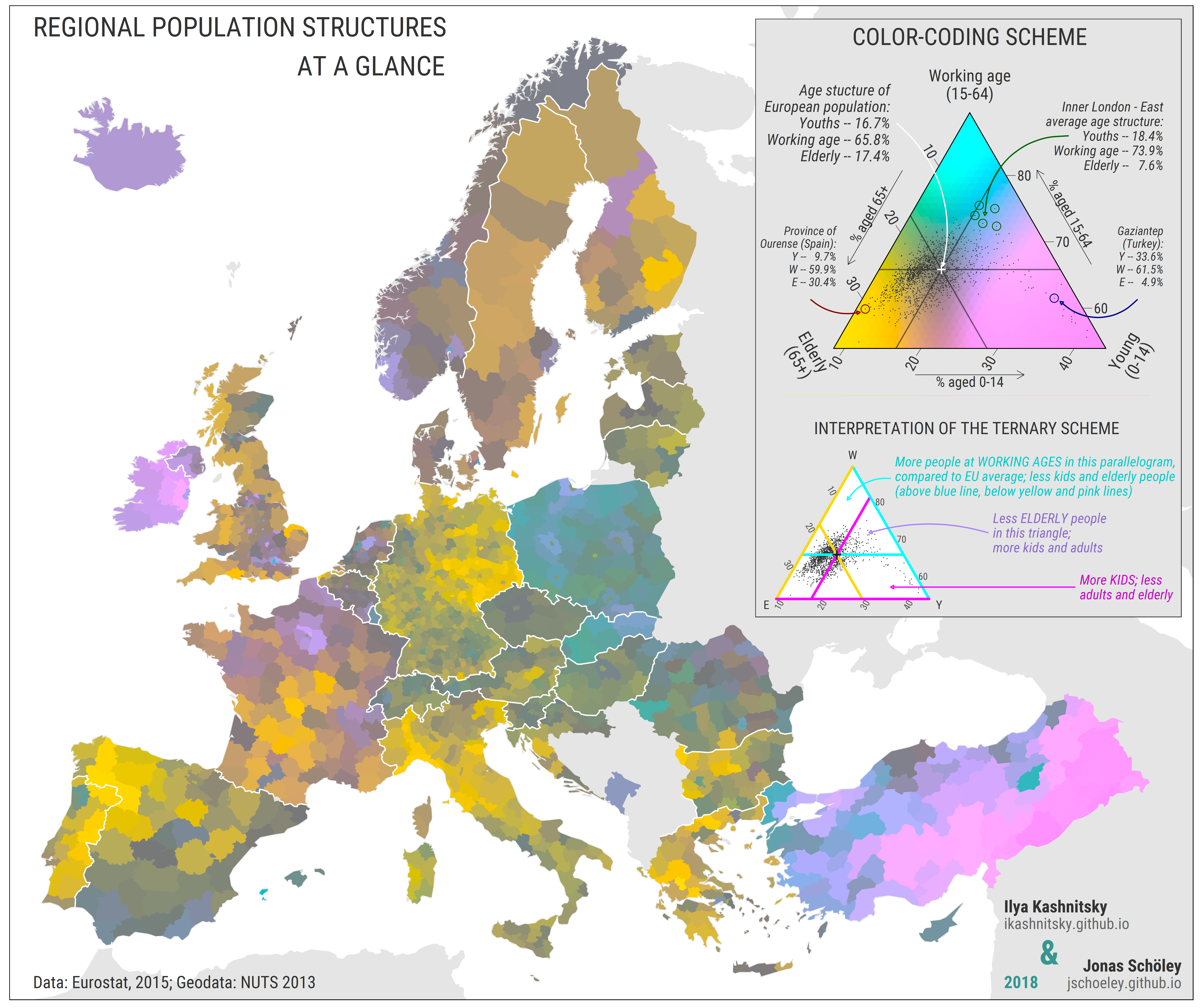Europe: regional population structures at a glance
Population aging is a major demographic challenge for humanity. Since population structures evolve slowly and predictably, the demographic, economic, environmental, and social problems of aging have been anticipated and discussed for many decades. Yet the focus of these discussions has always been the elderly population, with elderly people often defined as those older than a threshold—eg, 65 years or age at retirement—or with a certain number of estimated remaining years of life. Such a focus is quite reasonable and understandable but not entirely correct. Aging is not exclusively about the size of the elderly population or its proportion of a population; aging is a function of the entire age distribution of a population. Therefore, to better understand aging, we need to focus on the evolution of the age structure of the entire population, not just the elderly part.
Ilya Kashnitsky and Jonas Schöley mapped the diversity of population aging in Europe, using ternary color coding—a technique that maximizes the amount of information conveyed by colors. With this approach, each element of a three-dimensional array of compositional data is represented by a unique color.
The diverse picture of the color-coded age structure of European regions indicates the varying stages of population aging across Europe. The process of population aging is not occurring uniformly in all areas of Europe11 and regions differ substantially: eastern Europe is still undergoing a demographic dividend, southern European regions are forming a cluster of lowest-low fertility, the baby boomers are aging in Western Europe, urban regions are attracting young professionals and forcing out young parents, and peripheral rural regions are losing their youths forever. Color coding allows the mapping of all regional population structures in Europe simultaneously. The map below is not meant to easily inform the reader of the exact population structure in a specific region, rather, it provides a highly detailed snapshot of all the regional population structures, facilitating comparisons between them. One limitation of the approach is that the maps are not easily interpreted and usable by those who are color blind; however, our generalized function that mixes colours9 makes it easy to change colors by rotating the color space, thus enabling those who are color blind to use this setting more readily.
In the map, we can clearly see large-scale and small-scale regional differences in population structures. At the macro level, the distinctions between eastern, western, and southern Europe are evident. Eastern Turkey is the only example of a society that is still in the early stages of demographic transition. At the country level, the center-periphery contrasts are prominent. We can easily spot all capital regions and major urban areas that have a large working-age population, and their surrounding areas where families with kids tend to settle (ie, the suburbs of Paris). The population of the remote periphery ages at an accelerated pace because of the out-migration of young individuals. Country borders are highly important because they often demarcate territories with different demographic histories (ie, the Germany–Poland border). The map also reveals the signs of recent changes in population structures. For example, Spain received a large influx of international migrants in the 2000s, eastern Germany experienced a draining effect of out-migration coupled with a decrease in fertility in the past few decades, and Poland has had a massive labor out-migration because of European Union integration and more labor migrants moved from major Polish cities. The map below is a snapshot of the European population at the regional level, and it tells numerous demographic stories.
A color-coded map of population structures in European Nomenclature of Territorial Units
Each population composition in the European Nomenclature of Territorial Units for Statistics 3 regions is uniquely color-coded. Colors show the direction and magnitude of deviations from the center point, which represents the average age of the European population, and is dark grey (Youths – 16.7%, Working age – 65.8%, Elderly – 17.4%). The hue component of a color encodes the direction of deviation: yellow indicates an elderly population (>65 years), cyan indicates people of working age (15–64 years), and magenta indicates children (0–14 years). Chroma and lightness components signify the distance from the center ranging from desaturated and dark colors near the center to vivid and bright colors at the corners. We provide R code to fully reproduce this map.
Key Findings
- Eastern Europe’s Youth Dividend: While much of Europe grapples with aging populations, parts of Eastern Europe are experiencing a “demographic dividend” with a higher proportion of working-age individuals.
- Southern Europe’s Fertility Conundrum: Notice those distinctive hues in Southern Europe? They’re highlighting regions grappling with “lowest-low fertility” rates, a demographic challenge with far-reaching implications.
- The Baby Boomer Wave: Western Europe’s colors reflect the aging of the influential baby boomer generation, a demographic shift that’s reshaping societies and economies.
- Urban Magnets and Suburban Families: Spot those vibrant cyan areas? They’re major urban centers attracting young professionals. The softer hues surrounding them? That’s where young families are setting up homes in the suburbs.
- The Rural Brain Drain: Those yellow-tinged peripheral areas tell a story of rural regions losing their youth to urban opportunities, accelerating the aging process in these communities.
For readers who want to explore the data further, Kashnitsky and Schöley’s research is fully reproducible. The researchers even provide R code for recreating the map, so you can experiment with your own visualizations.
Source: Kashnitsky, I., & Schöley, J. (2018). Regional population structures at a glance. The Lancet, 392(10143), 209–210. https://doi.org/10.1016/S0140-6736(18)31194-2 (GitHub)








